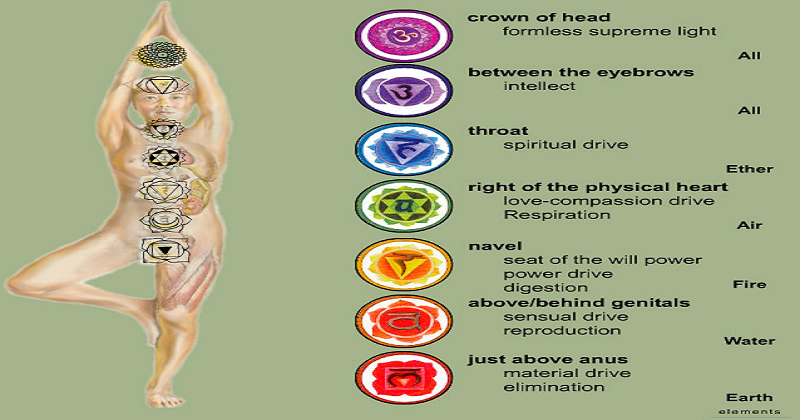
The chakras are centres of energy in the astral body. The Sanskrit word Chakra is symbolic for a wheel or spinning vortex. There are six chakras located along the Sushumna, or spinal cord, and a seventh at the crown of the head. All are depicted with a certain number of petals, corresponding to the number of nadis emanating from them. Nadis are nerve channels or tubes in the astral body through which prana, or energy flows. Each petal represents a sound vibration produced when the Kundalini energy passes through the chakra. All the chakras except the Sahasara, the crown chakra, have their own colour and mantra, or sound, associated with it.
At the base of the spine sits Muladhara, or root chakra. It is portrayed as a lotus with four petals. This chakra is located at the base of the spine in the coccygeal region. The color is red for Muladhara. It symbolizes groundedness, foundation, stability and prosperity. The activating sound for this chakra is LAM. It is here that Kundalini lies dormant.
Next is Svadhisthana, or sacral chakra. It is depicted as a six petal lotus located at the sacrum. The colour is orange. It symbolizes movement, connection, desire and pleasure. The syllable sound for this chakra is VAM.
Manipura or solar plexus/navel chakra is symbolized by a ten-petal lotus. The colour is yellow and the seed syllable is RAM. Manipura is representative of will, self-esteem, power, energy and activity.
Anahata, or heart chakra, is symbolized by a twelve-petal lotus and is green in colour. Located in the heart region, the sound mantra for this chakra is YAM. It relates to love, balance, self-love, relationship and devotion.

Vishuddha, or throat chakra, is depicted as a 16 petal lotus and blue in colour. The sound is HAM. It symbolizes self-expression, finding one’s voice, creativity, good listening, and the right to be heard.
Ajna chakra, located between the eyebrows, or third eye area, is depicted as a two petal lotus. The colour is violet, indigo or deep blue. The activating syllable for this chakra is OM. Ajna relates to intuition, imagination, dreams, insight and vision.
And last, Sahasrara, the thousand-petaled crown chakra, is the seventh and highest chakra. Located at the crown of the head, it is depicted as a brilliant white light, or violet in colour. The Sahasrara chakra represents divinity, union, vision and understanding.
Activating the chakras allows the passageway for Kundalini to reach the crown chakra. Kundalini, the Sanskrit word for “coiled one”, is a primal energy located at the base of the spine. The Yoga Upanishads describe Kundalini as lying “coiled” at the base of the spine, represented as either a goddess or sleeping serpent waiting to be awakened.
As Kundalini passes through each of the chakras, different states of consciousness are experienced. Different traditions teach methods of “awakening” Kundalini. Yoga breathing techniques and practices activate and arouse Kundalini, causing this dormant energy source to rise up through the chakras. When it reaches the Sahasrara, the thousand-petaled crown chakra, the yogi attains Samadhi. Still operating on the material plane, the yogi has reached a level of existence beyond time and space. When Kundalini rises to this point, a state of Samadhi is attained, that of spiritual enlightenment.

Post Your Comments